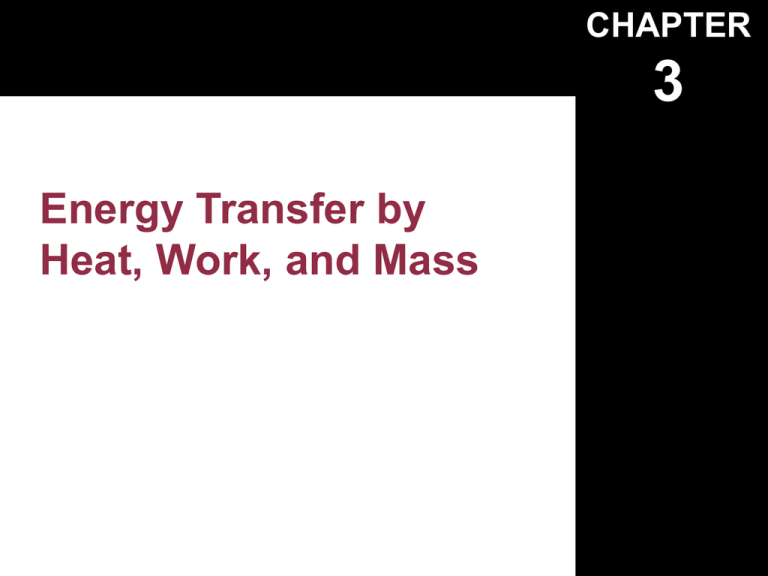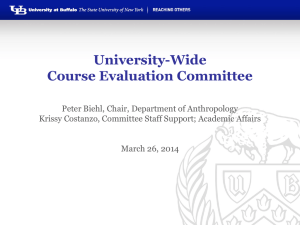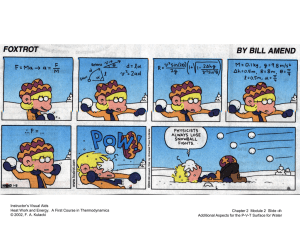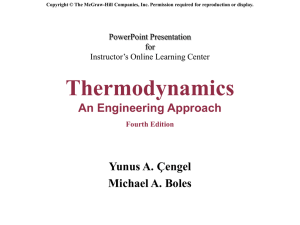Chapter 3-1
advertisement

CHAPTER 3 Energy Transfer by Heat, Work, and Mass Heat Transfer • Heat, means heat transfer. – Energy transfer driven by temperature difference – always hotter to cooler • Adiabatic – no heat transfer – same as isothermal? • Symbols used: – Q and q –Q • Caloric? Work • Energy transfer not driven by a temperature difference. Examples – Rising piston – rotating shaft – electric wire crossing the system boundaries • Symbols used: • W and w • W Copyright © The McGraw-Hill Companies, Inc. Permission required for reproduction or display. FIGURE 3-9 Specifying the directions of heat and work. Formally: Qin and Wout are positive, Qout and Win are negative 3-1 Heat and Work • Both heat and work are boundary phenomena. • Systems possess energy, but not heat or work. • Both are associated with a process, not a state. • Both are path functions – Magnitudes depend on paths as well as end states Instructor’s Visual Aids Heat Work and Energy. A First Course in Thermodynamics © 2002, F. A. Kulacki Chapter 3 Module 1 Slide ‹#› Work Processes P1 State 1 Process line, or path P3 P2 Instructor’s Visual Aids Heat Work and Energy. A First Course in Thermodynamics © 2002, F. A. Kulacki State 2 Chapter 3 Module 1 Slide ‹#› Work Electrical Work • We = VI • so We = VIΔt if V and I are constant. Instructor’s Visual Aids Heat Work and Energy. A First Course in Thermodynamics © 2002, F. A. Kulacki Chapter 3 Module 1 Slide ‹#› Work Mechanical Work W F d s F m ds s Instructor’s Visual Aids Heat Work and Energy. A First Course in Thermodynamics © 2002, F. A. Kulacki Chapter 3 Module 1 Slide ‹#› Work Quasi – equilibrium processes, best case. Work at a system boundary... There must be a force acting on the boundary. The boundary must move. Instructor’s Visual Aids Heat Work and Energy. A First Course in Thermodynamics © 2002, F. A. Kulacki Chapter 3 Module 1 Slide ‹#› Work Copyright © The McGraw-Hill Companies, Inc. Permission required for reproduction or display. FIGURE 3-19 A gas does a differential amount of work Wb as it forces the piston to move by a differential amount ds. 3-2 Work transfer at a boundary Surroundings System W>0 W< 0 System Boundary Instructor’s Visual Aids Heat Work and Energy. A First Course in Thermodynamics © 2002, F. A. Kulacki Chapter 3 Module 1 Slide ‹#› Work Work of Expansion p p gas pambient Wb x2 x1 Instructor’s Visual Aids Heat Work and Energy. A First Course in Thermodynamics © 2002, F. A. Kulacki pAdx Chapter 3 Module 1 Slide ‹#› Work Work of Expansion: p-dV work V2 Wb V1 dV Adx Instructor’s Visual Aids Heat Work and Energy. A First Course in Thermodynamics © 2002, F. A. Kulacki pdV p p(V ) Chapter 3 Module 1 Slide ‹#› Work Evaluating a equilibrium expansion process p p(V ) p p1 p2 V1 Instructor’s Visual Aids Heat Work and Energy. A First Course in Thermodynamics © 2002, F. A. Kulacki V2 V = Ax Chapter 3 Module 1 Slide ‹#› Work Copyright © The McGraw-Hill Companies, Inc. Permission required for reproduction or display. FIGURE 3-20 The area under the process curve on a P-V diagram represents the boundary work. 3-3 Copyright © The McGraw-Hill Companies, Inc. Permission required for reproduction or display. FIGURE 3-22 The net work done during a cycle is the difference between the work done by the system and the work done on the system. 3-4 PROCESSES INVOLVING IDEAL GASES Instructor’s Visual Aids Heat Work and Energy. A First Course in Thermodynamics © 2002, F. A. Kulacki Chapter 3 Module 2 Slide ‹#› Processes Involving Ideal Gases Polytropic processes... Instructor’s Visual Aids Heat Work and Energy. A First Course in Thermodynamics © 2002, F. A. Kulacki Chapter 3 Module 2 Slide ‹#› Processes Involving Ideal Gases The polytropic process: n PV =Const. State 1 p State 2 V Instructor’s Visual Aids Heat Work and Energy. A First Course in Thermodynamics © 2002, F. A. Kulacki Chapter 3 Module 2 Slide ‹#› Processes Involving Ideal Gases Assumptions • Changes in KE and PE are zero • Quasistatic process • Polytropic process • Ideal gas Instructor’s Visual Aids Heat Work and Energy. A First Course in Thermodynamics © 2002, F. A. Kulacki Chapter 3 Module 2 Slide ‹#› Processes Involving Ideal Gases Expression for work: V2 W1 2,by PdV V1 V2 P (V )dV V1 Process equation: PV C1 PV n 1 1 Instructor’s Visual Aids Heat Work and Energy. A First Course in Thermodynamics © 2002, F. A. Kulacki n Chapter 3 Module 2 Slide ‹#› Processes Involving Ideal Gases Evaluating the integral: W1 2,by C1 dV V1 V n P2V2 P1V1 1 n V2 Note that n cannot equal one, which is the general case. Instructor’s Visual Aids Heat Work and Energy. A First Course in Thermodynamics © 2002, F. A. Kulacki Chapter 3 Module 2 Slide ‹#› Processes Involving Ideal Gases For the special case when n = 1: W1 2,by C1 dV V1 V V2 P1 V1 ln V 1 Instructor’s Visual Aids Heat Work and Energy. A First Course in Thermodynamics © 2002, F. A. Kulacki V2 Chapter 3 Module 2 Slide ‹#› Processes Involving Ideal Gases Polytropic processes p Isothermal Process (n = 1) p1 p2 p2 T1 n>1 T2 V1 Instructor’s Visual Aids Heat Work and Energy. A First Course in Thermodynamics © 2002, F. A. Kulacki V2 V Chapter 3 Module 2 Slide ‹#› Processes Involving Ideal Gases Alternative expressions for W1-2 W1 2 W1 2 mR T2 T1 , n 1 1 n V2 m RT ln , n 1 V1 Instructor’s Visual Aids Heat Work and Energy. A First Course in Thermodynamics © 2002, F. A. Kulacki Chapter 3 Module 2 Slide ‹#› Processes Involving Ideal Gases Constant pressure processes... Instructor’s Visual Aids Heat Work and Energy. A First Course in Thermodynamics © 2002, F. A. Kulacki Chapter 3 Module 2 Slide ‹#› Processes Involving Ideal Gases Constant pressure process • Consider as a limiting case of the general polytropic process. • P = Constant • Evaluation of the work integral V2 W13 PdV P(V2 V1 ) V1 Instructor’s Visual Aids Heat Work and Energy. A First Course in Thermodynamics © 2002, F. A. Kulacki Chapter 3 Module 2 Slide ‹#› Processes Involving Ideal Gases Constant pressure, constant temperature and polytropic processes: P 1 P = Constant (n = 0) Isobaric process n 1 n 1 2 V Instructor’s Visual Aids Heat Work and Energy. A First Course in Thermodynamics © 2002, F. A. Kulacki Chapter 3 Module 2 Slide ‹#› Processes Involving Ideal Gases Shaft Work • Work = F∙d – Replace force with torque, T – Replace distance with angle rotated = 2πn • where n is number of rotations • Wsh = T(2πn) or • Wsh = T(2πn) where n is frequency in Hz Instructor’s Visual Aids Heat Work and Energy. A First Course in Thermodynamics © 2002, F. A. Kulacki Chapter 3 Module 1 Slide ‹#› Work







